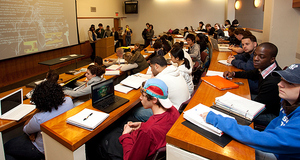From Elon Journal of Undergraduate Research in Communications VOL. 6 NO. 2How University Websites Portray Study Abroad
IN THIS ARTICLE
KEYWORDS
AbstractUniversity websites across the country showcase the important underlying values of study abroad: experiencing a "local" culture, creating interactive conversations, and empowering students through personal and academic development. This research examined how universities communicate the benefits and values. Through a rhetorical analysis, grounded in framing theory, this study analyzed the key verbal, visual, and interactive messages of five university study abroad websites. These findings suggest how website communication can influence perceptions of study abroad. I. IntroductionStudy abroad has become an important aspect in higher education in the United States, as the phenomenon of globalization has grown increasingly important to how universities equip students for the professional and social world. In 2014, the Institute of International Education proposed the Generation Study Abroad campaign to provide more study abroad opportunities, with the goal of reaching 600,000 students studying abroad by 2019, more than a twofold increase from the 2013-2014 academic year ("Generation Study Abroad," 2014). As study abroad becomes more relevant and timely for university students, many have begun to evaluate the study abroad experience and its academic, professional, and social outcomes. Intercultural competence has been seen as a valuable outcome for students, and scholars have worked to define and promote intercultural competences within the study abroad setting. While study abroad has been researched from a social and cultural perspective, not many researchers have examined study abroad through a communication lens. In order for university study abroad programs to be successful, most universities promote study abroad through websites. Recent research has found that some study abroad websites and marketing tools tend to float on the border between promoting educational tourist experiences and authentic intercultural exchanges. According to Erving Goffman's (1974) framing theory, communication tools seek to shape perceptions and realities on different issues, which means that websites are not neutral texts when it comes to communicating study abroad. In order to form a larger perspective on study abroad marketing, it is necessary to examine the rhetoric and language on university websites and to understand how they compare to intercultural competence frameworks and global understanding. II. Literature ReviewThe literature below surveyed the status of study abroad; the importance of intercultural competence in study abroad programs; channels used to promote study abroad, especially websites; and the application of framing theory in creating university web content. The State of Study AbroadIn order to analyze the marketing efforts of key universities' study abroad websites, it is important to understand the broader historical context of study abroad in the United States. Over the past two decades, U.S. participation in study abroad has more than tripled, with more than 280,000 students studying abroad for academic credit in the 2012-2013 academic year (Institute of International Education, 2014). Currently, almost all universities have study abroad programs or are working to include international programs into their institutions. In 2008, more than 90% of colleges and universities in the United States offered study abroad programs (Green, Luu, & Burris, 2008, p. 1). Study abroad has been an important goal for American universities in promoting internationalization in higher education and has been backed by other parties, such as the federal government, business communities, nonprofits, and major higher education associations ("History and Purposes," 2012, p. 21). President George W. Bush signed the Senate Resolution 308 in 2005, in which 2006 was declared to be "The Year of Study Abroad" and global competency and literacy were assumed to be a responsibility of American educational systems. Study abroad programs have allowed universities to respond to national and international calls to ensure quality education for U.S. citizens in an increasingly globalized society. Advancing study abroad has potential to make universities more competitive, as 79% of people in the United States believe that students should study abroad in college, according to a 2002 American Council on Education poll ("Designating 2006," 2005). Many studies outline other benefits of study abroad both for students and for the university as a whole. For example, study abroad programs promote American universities in an international context, offering the chance to build global education partnerships (Bishop 2013, p. 399). In addition, studies have shown other positive outcomes, such as increased academic performance (Holoviak, Verney, Winter, & Holoviak, 2011), self-confidence, long-lasting career impact, and professional skills (Franklin, 2010, p. 186). Research has also shown other personal outcomes for students who study abroad, including greater intercultural proficiency, increased openness to cultural diversity, global mindedness, and effective intercultural communication skills (Clarke, Flaherty, Wright, & McMillen, 2009, p.174-175). Because these benefits are key selling points of the study abroad experience, it will be important to study how universities portray these benefits to students and the university community interested in study abroad. While many see the value of study abroad, not many undergraduates participate in overseas education programs. Less than 10% of students study abroad during their degree program, and 71% of the students who study abroad are within the social sciences, humanities, and business disciplines (Institute of International Education, 2014). Even though study abroad programs are catering to the needs of different students, such as offering language immersion programs, courses in different majors, opportunities for internships and service, and extracurricular activities, a variety of other factors may influence students' decisions to study abroad. As colleges and universities continue to value and promote education centered on gaining intercultural experience and preparing students for a globalized world, universities' views on intercultural competence may influence students' desires and decisions during their study abroad process. Recognizing Intercultural Competence as a Key Aspect of Study AbroadAs mentioned earlier, intercultural competence has become a buzzword among educators who have focused on increasing intercultural dialogue in the United States and abroad. Intercultural competence has become more significant when examining the influence of study abroad on academics and career advancement. Scholars have discussed various frameworks of intercultural competence and explored ways students can develop it (Deardorff, 2010, p. 87). Many studies formulate definitions and frameworks for intercultural competence (Bennett, 2011; Williams, 2012). Putting together a body of knowledge, the Association of American College and Universities (AAC&U) released its Intercultural Knowledge and Competence Value Rubric, which offers a definition, glossary of key terms, and framework for evaluating intercultural knowledge, skills and attitudes, from benchmark to capstone (2010). The rubric adopts the definition of intercultural competence from scholar Janet Bennett (2008), describing it as "a set of cognitive, affective and behavioral skills and characteristics that support effective and appropriate interaction in a variety of cultural contexts." The rubric was built upon previous work from developmental models and research of Milton Bennett, Darla K. Deardorff, and Janet Bennett, whose individual works have made important contributions to the study of intercultural sensitivity and competence. Along with the definition for intercultural competence, the AAC&U rubric also outlines key aspects of intercultural competence that can be measured based on student experiences. These include cultural self-awareness, knowledge of cultural worldview frameworks, empathy, verbal and nonverbal communication, curiosity, and openness. The AAC&U rubric has been a key development in bringing intercultural competence to the forefront of higher education, giving educators and scholars tools to understand how intercultural competence develops and why it is important. Other bodies of knowledge also define, simplify, and outline the concept of intercultural competence. Bennett's work offers some facts on intercultural competence. She specifies that cultural knowledge and contact do not necessarily lead to competence; however, they may reduce stereotypes. In addition, she stresses that intercultural competence doesn't just happen for most people, rather it must be intentionally cultivated and developed in people, through various means, such as effective program design; competence training; and stimulating learning before, during, and after intercultural experiences (Bennett, 2011, p. 5). Because communication plays a key role in spreading information about intercultural experiences through study abroad, university websites play important roles in the intentionality of cultivating intercultural competence in its students. It has been noted that some university websites specifically mention global competencies (Li, Olson, & Frieze, 2013, p. 74); however, more detail is needed to get a larger picture on how intercultural competence is communicated as a whole. Therefore, looking at the ways universities communicate intercultural competence through study abroad websites will show how intercultural exchanges are visually and textually portrayed, and what values are being promoted to students. Evaluating the Effect of Study Abroad MarketingWhile many scholars have researched study abroad with an academic or cultural lens, only some have examined the unique context of the study abroad experience from a marketing or communication perspective. Lukosius and Festervand (2013) developed a conceptual framework for marketing study abroad programs and recruiting students. Their framework includes four components that examine 1) the student segments targeted, 2) overall program cost, 3) timing and duration of the programs, and 4) the promotion and marketing of the programs. According to their framework, the promotion of study abroad should be prepared ahead of time and should include an integrated marketing communication plan with multiple outlets for promotion. The framework incorporates social media and website marketing, which continue to be a part of integrated communications plans that universities use to promote study abroad. As technology and communication tools evolve, universities have promoted study abroad through poster campaigns, advertisements in campus newspapers or magazines, social media, videos, and websites. Due to the ways communication can frame the meanings of experiences like study abroad, researchers have been intrigued by the visual and verbal rhetoric and content found in study abroad publications, both in print and digital forms. Bishop (2013) analyzed three university websites' study abroad content, concluding that these websites emphasized the cultural immersion aspects of study abroad, the promises for transformative or "life-changing" experiences, and some cultural homogeneity (p. 398). Bishop (2013) argued that the online rhetoric of the websites had potential to frame the study abroad experience, demonstrating how reality can be produced and revealed through communication — making university study abroad websites act like advertisements (p. 410). Other studies have examined study abroad marketing by non-university organizations, such as Semester at Sea (SAS), a nonprofit travel educational program. Caton and Santos (2009) concluded that SAS's depictions of cross-cultural interactions through images on its website and printed brochure show evidence of colonialist stereotypes about non-Western cultures (p. 11). The study compared the study abroad marketing materials to tourism marketing and representations of cultural "others," suggesting that there is much similarity between other tourism organizations and SAS, at least in terms of communication and marketing. Others analyzed study abroad rhetoric in books or travel guides, genres that do not formally promote a particular university program, but rather offer stories or advice about study abroad. For example, Doerr (2012) examined the discourse of study abroad guidebooks, other important texts in a study abroad experience. Viewing study abroad as "adventure," the study found that the guidebooks accentuated the differences between the host's and student's cultures, creating an unbalanced view of the two societies (p. 265). Overall, cultural hegemony and the incorporation of cultural "others" are large themes in study abroad literature, and will be important when examining the rhetoric of study abroad websites at the university level. Websites as Marketing ToolsAccording to Bishop (2013), the university website is often the first reference for a student when researching study abroad programs (p. 400). She explains that study abroad websites cater to prospective applicants by using verbal and visual imagery to engage student populations. Because websites tend to be the first choice for getting information about study abroad, it is important to view university websites as relevant artifacts of language and communication, crucial to researching study abroad marketing. University websites have served as subjects of research in various studies. For example, Yoo and Jin (2004) evaluated the design and features of the homepages of the top university websites from U.S. News & World Reports. Another study also found that university websites were effective in providing useful information for students; however, they could improve features that promote more dialogic, two-way interactions between students and the institutions (Gordon & Berhow, 2009, p. 152). From a marketing perspective, websites can be seen as promotional outlets set in place in order to achieve a business or organizational goal. Some website scholars explain that all website communication has an ultimate goal: to "achieve positive response action from every visitor" (Sharp, 2001, p. 42). Positive response actions could mean a visitor remaining on the website for an optimum period of time, downloading content from the site, forwarding content to another person, purchasing an item, subscribing for more information, or returning to the website at a later time. When study abroad websites subscribe to this theory, they should strive to engage visitors so they would use the website for information, apply to a study abroad program, or share the information with other people interested in the study abroad process. Because websites are crucial in promoting study abroad to students, it is important to observe how website communication, rooted in the complex nature of university goals and ideologies, plays a role in making study abroad part of higher education. Determining how this communication frames the intercultural aspects of study abroad is the next step. Framing Theory and Study Abroad WebsitesThis research, as well as other studies of website rhetoric and content, is grounded in the framing theory of communication, first outlined by Erving Goffman (1974). He suggested that frames allow individuals to assign meaning to experiences and actions, making framing a way to interpret and communicate reality. Framing is a way to understand the background of each party involved in a conversation or interaction. In communication theory, framing has become a way to adjust the audience's perception and awareness about particular issues, as media and communication outlets can stress certain viewpoints over others ("Framing," 2010). It is important to note that framing has been applied to both organizational communications as well as public relations theory (Johansson, 2007, p. 277), with the emphasis that organizations and publics, such as universities and students, need to establish common frames of reference for them to maintain mutually beneficial relations. In the case of study abroad websites, universities' online rhetoric may frame students' perceptions and experiences of study abroad, as well as their awareness of intercultural competences gained by an international experience. As with other research on study abroad rhetoric (Bishop, 2013), this analysis of study abroad messages on university websites does not seek to judge the online communication as positive or negative, but rather present the different ways to portray study abroad to students through online channels. This study aimed at gauging the current state of how universities portray intercultural experiences through study abroad websites. To achieve this goal, this study asked the following research questions:
Suggested Reading from Inquiries Journal
Inquiries Journal provides undergraduate and graduate students around the world a platform for the wide dissemination of academic work over a range of core disciplines. Representing the work of students from hundreds of institutions around the globe, Inquiries Journal's large database of academic articles is completely free. Learn more | Blog | Submit Latest in Education |



















